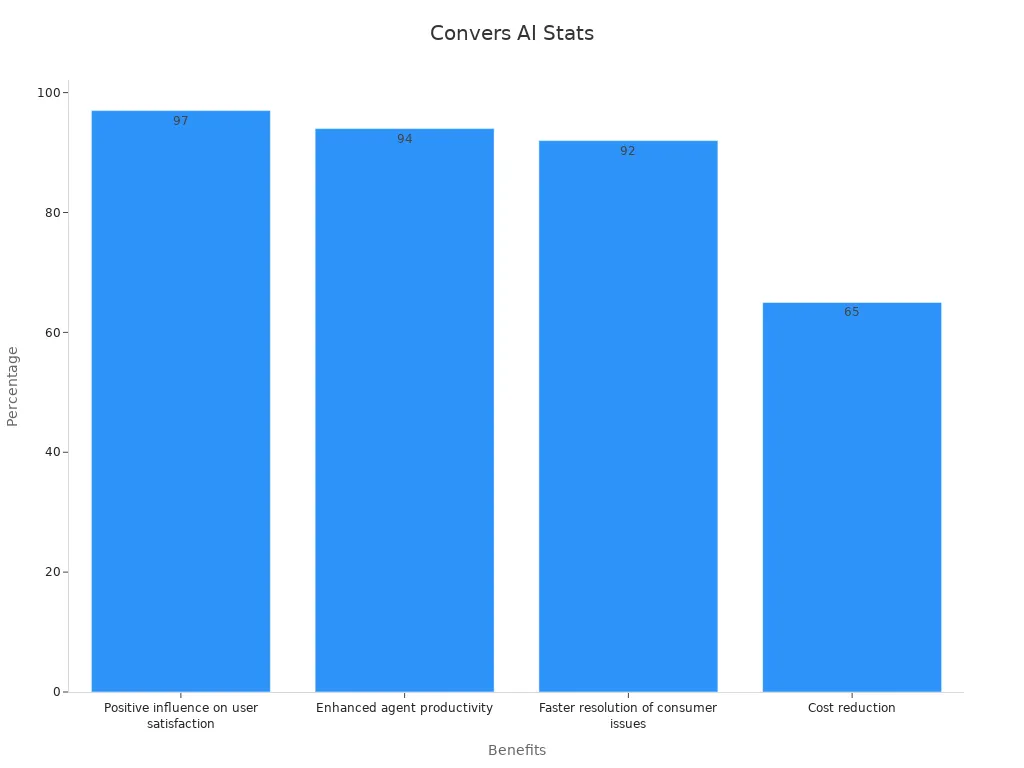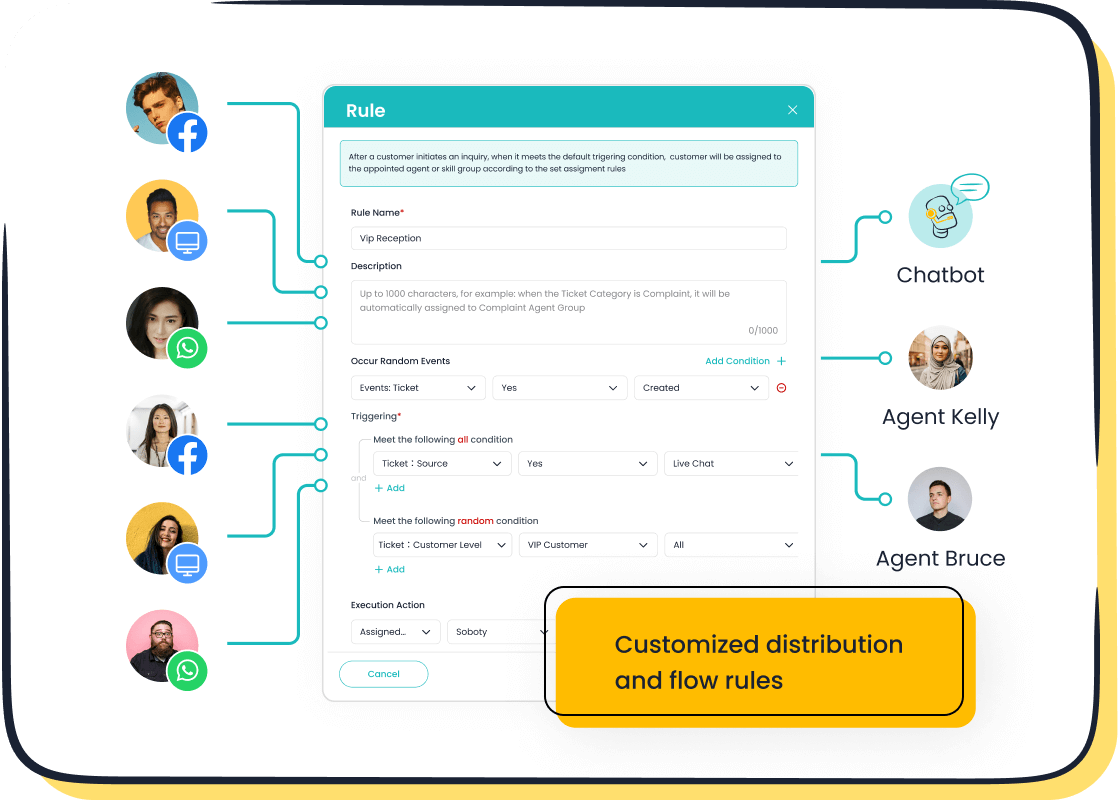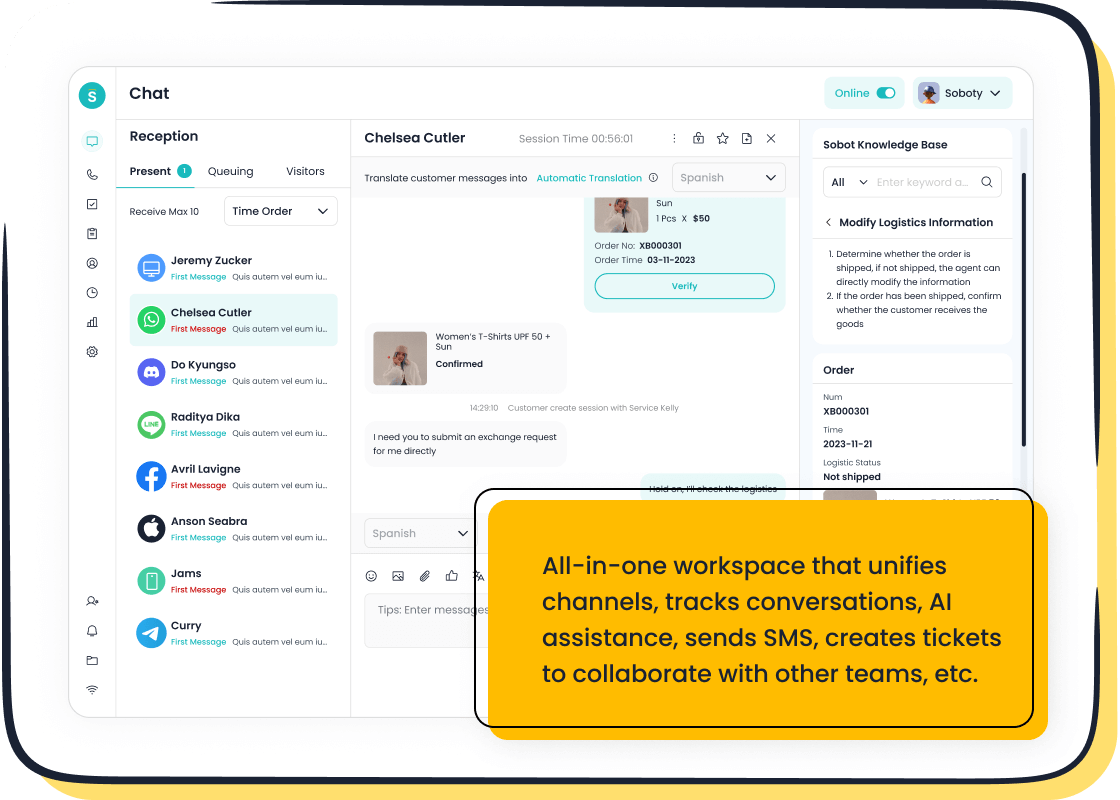Choosing the Right Conversational AI for eCommerce

The rise of conversational AI eCommerce is revolutionizing how businesses approach customer service. This isn't merely a passing trend—it's a transformative shift. Companies leveraging AI report a 37% faster first response time and resolve tickets 52% more efficiently. By 2025, 80% of businesses are expected to adopt AI-powered chatbots. However, choosing the right solution can be daunting. How do you identify the perfect fit for your business? Platforms like Sobot provide cutting-edge features, but understanding your specific needs is crucial to making the best decision.
Understanding Conversational AI in eCommerce

What is conversational AI?
Conversational AI refers to technologies that enable machines to interact with humans through natural language. These systems use advanced tools like natural language processing (NLP) and machine learning to understand, process, and respond to user inputs. Unlike traditional chatbots, conversational AI systems can handle complex queries, learn from interactions, and provide personalized responses.
The global conversational AI market is growing rapidly. It was valued at $13.2 billion in 2024 and is projected to reach $49.9 billion by 2030, with a 24.9% compound annual growth rate (CAGR). This growth is fueled by advancements in NLP and the increasing popularity of online shopping, which now involves approximately 33% of the global population.
Key applications of conversational AI in eCommerce
Conversational AI plays a vital role in eCommerce by enhancing customer interactions. Here are some key applications:
- Personalized Shopping Assistance: AI tools for eCommerce, like chatbots, help customers find products based on their preferences. For example, L'Oréal's Beauty Gifter achieved 27 times higher engagement than email campaigns.
- Customer Support: AI-powered systems provide instant answers to common questions, reducing wait times and improving user experience.
- Adaptive Customer Segmentation: AI analyzes customer behavior to create targeted promotions. A jewelry store using this approach saw a 67% increase in sales.
- Feedback and Engagement: Conversational AI encourages customers to share feedback, boosting engagement. Ben & Jerry's used AI to achieve five times more social media engagement and a 20% sales increase.
| Application | Case Study | Results |
|---|---|---|
| Adaptive Customer Segmentation | Jewelry Store | 67% increase in sales due to targeted promotions based on customer segmentation. |
| Personalized Shopping Assistance | L'Oréal's Beauty Gifter | 27X higher engagement than email, 31% rich profiling, 82% customer satisfaction. |
| Customer Feedback and Engagement | Ben & Jerry's | 5X more engagement on social media, 20% increase in sales, all free samples distributed. |
Benefits of conversational AI for eCommerce businesses
The benefits of conversational AI in eCommerce are transformative. These systems enhance customer relationships and improve sales conversion rates. By tailoring interactions at scale, they reduce the burden on human agents while increasing efficiency. Research shows that AI customer service can increase average order value by up to 47%. Companies offering excellent customer experiences grow revenues 4%-8% faster than their competitors.
AI-powered systems also ensure personalized experiences and proactive support. They provide data-driven insights that refine customer care strategies and improve recommendations. This leads to increased customer loyalty and higher lifetime value. Additionally, faster issue resolution and cost reduction make conversational AI an essential tool for modern eCommerce businesses.

Key Criteria for Choosing Conversational AI Tools
Integration with eCommerce platforms and systems
When selecting conversational AI tools, seamless integration with your existing eCommerce platforms is essential. A well-integrated system ensures smooth workflows, enabling you to manage customer interactions efficiently. For example, connecting AI tools with platforms like Shopify or Salesforce allows you to synchronize customer data, track orders, and provide real-time updates. This integration improves operational efficiency and enhances the user experience.
Metrics such as conversion rate improvement and customer satisfaction scores highlight the importance of integration. AI tools for eCommerce that integrate effectively can boost engagement metrics and ROI. They also adapt to market changes, ensuring scalability and long-term success. By choosing a solution that aligns with your current systems, you can optimize processes and deliver personalized experiences to your customers.
| Metric | Description |
|---|---|
| Conversion Rate Improvement | Measures how AI converts visitors into paying customers. |
| Customer Satisfaction Scores | Gauges the impact of AI on the shopping experience. |
| Operational Efficiency | Assesses how AI improves processes like order tracking and customer support. |
Customization and scalability for business growth
Your business needs a conversational AI solution that grows with you. Customization ensures the tool aligns with your brand's voice and meets specific customer needs. For instance, Lululemon used conversational AI to create personalized product recommendations, boosting customer engagement. Similarly, Netflix employed AI to generate targeted recommendations, improving lead generation.
Scalability is equally important. As your business expands, the AI tool should handle increased customer interactions across multiple languages and regions. AI-powered chatbots reduce call volumes by managing routine inquiries, freeing agents to focus on complex issues. This adaptability supports your growth while maintaining high service standards.
Natural Language Processing (NLP) capabilities
NLP capabilities are the backbone of effective conversational AI. These systems break down language into analyzable components, allowing them to understand and respond accurately to customer inputs. Natural language understanding (NLU) identifies user intent and extracts relevant information, while dialogue management ensures coherent responses by tracking conversation history.
Advanced NLP enables real-time, human-like interactions, enhancing the user experience. It also supports hyper-personalization, creating tailored recommendations based on customer behavior. Research shows that 64% of companies believe chatbots provide more personalized experiences than human representatives. By leveraging NLP, you can deliver faster resolutions, improve customer satisfaction, and drive business growth.
Analytics and reporting for data-driven decisions
Analytics and reporting are essential for making informed decisions in eCommerce. Conversational AI provides valuable insights by tracking key metrics that help you understand customer behavior and optimize your strategies. Metrics like customer lifetime value (CLV), average order value (AOV), and customer retention rate reveal how well your business engages and retains customers. For example, a high CLV indicates loyal customers who frequently purchase from you, while a low AOV might suggest opportunities for upselling or bundling products.
| Metric | What it is | Why it matters | How to improve it |
|---|---|---|---|
| Customer lifetime value (CLV) | Total revenue expected from a customer over time. | High CLV = loyal customers who keep spending. | Run personalized email campaigns and launch loyalty programs. |
| Average order value (AOV) | Average spend per transaction. | Higher AOV = more revenue without new customers. | Use bundles, cross-sell complementary items, and study purchase patterns. |
| Customer retention rate | Percentage of repeat customers. | High retention = happy, loyal customers. | Segment audiences and send tailored offers. |
By leveraging these insights, you can implement strategies like personalized product recommendations and pricing optimization to boost sales. Conversational AI tools also provide real-time reporting, enabling you to adjust your approach quickly. This data-driven decision-making process ensures continuous improvement and better customer support.
Multichannel support for seamless customer interactions
Your customers interact with your brand across multiple platforms, from websites to social media. Conversational AI ensures a seamless experience by unifying these channels into one system. This omnichannel approach improves customer satisfaction by 20%, reduces costs by 15%, and increases revenue growth by 10%. For instance, companies like Amazon have used omnichannel tools to achieve a 42% revenue increase.
To implement effective multichannel support, follow these steps:
- Create a structured feedback collection mechanism to capture customer insights.
- Analyze the feedback to identify trends and areas needing attention.
- Iterate on processes and training based on insights to enhance customer satisfaction.
With conversational AI, you can provide consistent and personalized interactions across all channels. This not only improves customer engagement but also builds trust and loyalty.
Pricing and ROI considerations
Investing in conversational AI for eCommerce requires careful evaluation of pricing and ROI. AI tools for eCommerce reduce costs by automating repetitive tasks, allowing human agents to focus on complex issues. Chatbots alone can cut customer service costs by 30%, saving industries up to $11 billion annually. Additionally, predictive analytics helps with pricing optimization, ensuring you maximize profits while meeting customer expectations.
| Statistic/Prediction | Description |
|---|---|
| 34% | Retail users comfortable with virtual assistants. |
| 30% | Potential cost reduction in customer service through AI. |
| $11 billion | Annual savings for industries due to AI chatbots. |
By integrating conversational AI, you can enhance customer satisfaction through quick and accurate responses. This leads to increased loyalty and higher conversion rates. Businesses using these systems report improved average order values and better marketing ROI. As your business grows, these tools adapt, ensuring long-term benefits and sustainable growth.
Comparing the Best Conversational AI Tools for eCommerce

Overview of top AI tools for eCommerce
When choosing conversational AI for your business, understanding the top tools available is essential. Each tool offers unique features tailored to different needs. For example:
- Competera provides detailed competitor analytics and alerts, helping you stay ahead in pricing strategies.
- Intelligence Node excels at real-time dynamic pricing, ensuring your products remain competitive.
- PriSync is known for its ease of use and immediate ROI, making it ideal for small businesses.
- Polar Analytics offers conversational AI for forecasting and analysis, helping you make data-driven decisions.
These tools cater to various aspects of eCommerce, from pricing optimization to customer engagement. Selecting the right one depends on your business goals and operational requirements.
Features and strengths of leading tools
The best conversational AI tools share common strengths that enhance their effectiveness. These include:
- Real-time monitoring of user satisfaction, allowing you to respond quickly to customer needs.
- Advanced analytics capabilities, such as sentiment analysis and trend tracking, which provide actionable insights.
- The ability to analyze user interactions, helping you understand customer behavior and improve engagement strategies.
| Feature/Strength | Description |
|---|---|
| Analyze user interactions | Tools can effectively analyze how users interact with AI systems, providing insights into usage. |
| Real-time monitoring of satisfaction | These tools enable businesses to monitor user satisfaction in real-time, allowing for quick responses. |
| Advanced analytics capabilities | They offer advanced analytics that can provide actionable insights, enhancing decision-making. |
These features not only improve customer experiences but also help you boost sales by optimizing your strategies.
Ideal use cases for different business sizes and industries
Conversational AI is versatile, making it suitable for businesses of all sizes and industries. Small businesses can use AI chatbots to handle routine inquiries, reducing operational costs. Medium-sized companies benefit from AI-driven product recommendations, which increase average order value. Large enterprises can leverage eCommerce chatbots to manage high volumes of customer interactions across multiple channels.
AI applications span sectors like healthcare, retail, travel, and manufacturing. For example, in retail, conversational AI helps personalize shopping experiences, while in travel, it assists customers with booking and itinerary changes. This adaptability ensures that businesses across industries can use AI to enhance customer satisfaction and drive growth.

How Sobot Live Chat stands out as a leading eCommerce chatbot
Sobot Live Chat redefines how businesses interact with customers by offering a powerful and versatile ecommerce chatbot solution. It combines advanced technology with user-friendly features to deliver exceptional customer experiences. Whether you're a small business or a global enterprise, Sobot Live Chat adapts to your needs and scales with your growth.
One of its standout features is omnichannel support. Sobot Live Chat connects with platforms like WhatsApp, Facebook, Instagram, and Telegram, ensuring you never miss a customer interaction. This seamless integration across channels enhances customer satisfaction and builds loyalty. For example, businesses using Sobot Live Chat have reported a 38% increase in conversion rates, turning more visitors into paying customers.
The platform's AI chatbot capabilities set it apart. It uses natural language processing to understand customer queries and provide accurate responses. This ensures faster resolutions and reduces the workload on your support team. Additionally, the AI chatbot offers multilingual support, making it ideal for businesses with a global audience.
Sobot Live Chat also excels in analytics and reporting. It evaluates over 150 indicators, providing actionable insights to optimize your customer service strategies. These insights help you make data-driven decisions, such as improving response times or identifying trends in customer behavior. With built-in analytics, you can refine your approach and boost overall efficiency.
Customization is another key strength. Sobot Live Chat allows you to tailor its features to match your brand's identity. From customizable widgets to intelligent assignment workflows, the platform ensures a personalized experience for your customers. This level of customization, combined with its AI chatbot capabilities, makes it a leading choice for ecommerce businesses.
If you're looking for a reliable ecommerce chatbot that delivers measurable results, Sobot Live Chat is the solution you need. Its advanced features, scalability, and data-driven approach make it a valuable asset for any business aiming to enhance customer engagement and drive growth.
Ready to transform your customer interactions? Explore Sobot Live Chat today: Sobot Live Chat.
Common Challenges and Mistakes to Avoid
Over-reliance on automation without human oversight
Relying too heavily on automation can harm your customer service strategy. While AI customer service tools like chatbots are efficient, they are not flawless. AI systems can misinterpret user intent or provide incorrect answers, leading to customer dissatisfaction. Without human oversight, these errors can escalate, causing a loss of trust in your brand. For example, AI hallucinations—when AI generates inaccurate information—can confuse users and damage your credibility.
Over-reliance on AI also risks degrading critical thinking skills within your team. When employees depend solely on AI outputs, their decision-making abilities may weaken. This can reduce the effectiveness of human-AI collaboration, leading to poor customer engagement. To avoid these pitfalls, ensure that human agents monitor AI interactions and intervene when necessary. This balance enhances the overall performance of your ai-powered customer support system.
Poor integration with existing systems
Integration challenges often arise when implementing AI customer service tools. Poorly integrated systems can create bottlenecks, disrupt workflows, and lead to inefficiencies. For instance, unstable middleware platforms or architectural flaws can cause delays in processing customer queries. Additionally, incomplete or erroneous data can result in inaccurate responses, frustrating customers.
Budget constraints and a lack of skilled personnel further complicate integration efforts. Without proper expertise, businesses may struggle to configure systems effectively, leading to wasted resources. To overcome these challenges, invest in robust integration solutions and ensure your team has the necessary skills. A well-integrated system streamlines operations and improves customer support.
Lack of customization leading to generic interactions
Generic interactions fail to meet customer expectations. Research shows that 80% of consumers are more likely to purchase from brands offering personalized experiences. When AI systems lack customization, they deliver one-size-fits-all responses, which can alienate customers. This reduces the effectiveness of your ai customer service strategy and impacts customer loyalty.
Personalization enhances customer engagement by tailoring recommendations and responses to individual needs. For example, customized chatbots can analyze user behavior to provide relevant product suggestions. To achieve this, choose AI tools that allow for extensive customization. This ensures your brand voice remains consistent and your customers feel valued.
Ignoring customer feedback during implementation
Customer feedback plays a critical role in the success of your conversational AI implementation. Ignoring this valuable input can lead to missed opportunities for improvement and a poor user experience. When customers interact with your AI tools, they provide insights into what works and what doesn’t. Overlooking these insights can result in a system that fails to meet their expectations.
Why customer feedback matters
- Identifies pain points: Feedback highlights areas where your AI might be falling short, such as unclear responses or slow processing times.
- Improves user satisfaction: Listening to customers helps you refine your AI to better address their needs, leading to higher satisfaction rates.
- Drives innovation: Customers often suggest features or improvements you may not have considered. These ideas can help you stay ahead of competitors.
Tip: Use surveys, feedback forms, or direct interactions to gather customer opinions. Analyze this data regularly to identify trends and areas for improvement.
Consequences of ignoring feedback
Failing to act on customer feedback can harm your business in several ways:
- Decreased engagement: Customers may stop using your AI tools if they find them unhelpful or frustrating.
- Negative reviews: Dissatisfied users are more likely to share their experiences online, damaging your brand reputation.
- Wasted resources: Without feedback, you risk investing in features or updates that don’t address real customer needs.
How to incorporate feedback effectively
- Create a feedback loop: Regularly collect and review customer input to ensure your AI evolves with their needs.
- Prioritize actionable insights: Focus on changes that will have the most significant impact on user experience.
- Test updates: Before rolling out changes, test them with a small group of users to ensure they address the issues effectively.
By valuing customer feedback, you can create a conversational AI system that not only meets but exceeds user expectations. This approach fosters trust, loyalty, and long-term success for your eCommerce business.
Actionable Steps to Select the Right Conversational AI
Assessing your business needs and goals
Start by identifying what you want to achieve with conversational AI. Define your goals clearly. Do you want to improve customer satisfaction, reduce response times, or increase sales? Understanding your objectives will guide you in selecting the right tool.
Evaluate your current operations to pinpoint gaps. For example, if your team struggles with repetitive queries, an AI chatbot can help. Use metrics to assess your needs effectively:
- User Metrics: Track total users, engaged users, and goal completion rates to see how well the tool aligns with your objectives.
- Conversation Metrics: Analyze chat volume and bounce rates to measure interaction quality.
- Customer Satisfaction Metrics: Use CSAT and NPS surveys to gauge user satisfaction with chatbot interactions.
These insights will help you choose a solution that fits your business requirements.
Tip: Involve your team in this process. Their input can reveal operational challenges you might overlook.
Testing tools with free trials or demos
Before committing to a conversational AI tool, take advantage of free trials or demos. These allow you to explore features and evaluate performance in real-world scenarios. Test the tool’s ability to handle common customer queries. Check its response accuracy and speed.
Pay attention to the user interface. A simple and intuitive design ensures your team can use the tool effectively. Also, test its integration with your existing systems. For example, see if it syncs with your CRM or eCommerce platform.
Note: Use this opportunity to involve your support team. Their feedback will help you understand how the tool performs under actual conditions.
Consulting with vendors and reading reviews
Engage with vendors to learn more about their solutions. Ask detailed questions about features, scalability, and support services. Vendors can provide insights into how their tools address specific challenges.
Reading reviews from other businesses can also help. Look for feedback on ease of use, reliability, and customer support. Reviews often highlight strengths and weaknesses that may not be obvious during demos.
Tip: Focus on reviews from businesses in your industry. Their experiences will give you a clearer picture of how the tool performs in similar scenarios.
Starting small and scaling as needed
When adopting conversational AI for your eCommerce business, starting small is a smart strategy. Begin by identifying a single area where AI can make the most impact. For example, you could deploy a chatbot to handle frequently asked questions. This approach allows you to test the tool’s effectiveness without overwhelming your team or budget. It also helps you gather valuable insights into customer behavior and preferences.
Once you see positive results, you can scale the solution to cover more areas. For instance, expand its use to include personalized product recommendations or order tracking. Scaling gradually ensures that your team adapts to the new technology while maintaining service quality. It also allows you to refine the system based on real-world feedback.
Sobot Live Chat makes scaling easy. Its AI-powered tools adapt to your growing needs, whether you’re a small business or a global enterprise. The platform supports multiple languages and channels, ensuring seamless customer engagement as your business expands. By starting small and scaling strategically, you can maximize the benefits of conversational AI while minimizing risks.
Leveraging Sobot Live Chat for omnichannel customer engagement
Sobot Live Chat transforms how you interact with customers by offering a unified platform for omnichannel engagement. It connects seamlessly with websites, apps, and social media platforms like WhatsApp, Facebook, and Instagram. This ensures that your customers receive consistent and personalized support, no matter where they reach out.
The platform’s impact is evident in its performance metrics. Businesses using Sobot Live Chat report a 20% reduction in inbound discussion volume and a 96% increase in positive customer feedback. The AI system provides correct answers over 80% of the time, contributing to a customer satisfaction rate of over 95%. Additionally, the self-service question resolution rate stands at 22.2%, while the customer satisfaction score (CSAT) reaches an impressive 97%.
| Benefit Description | Statistic |
|---|---|
| Reduction in inbound discussion volume | 20% |
| Increase in positive feedback from customers | 96% + |
| Correct answers provided by the AI platform | Over 80% |
| Customer satisfaction rate | Over 95% |
| Self-service question resolution rate | 22.2% |
| Customer satisfaction score (CSAT) | 97% |
| Problems solved with Sobot solutions | 85% |
| Customer happiness rate | 99% |
| Increase in sign-off rate | About 35% |
| Increase in COD collection rate | About 40% |
These statistics highlight how Sobot Live Chat enhances customer engagement and operational efficiency. Its built-in analytics provide actionable insights, helping you optimize your strategies. By leveraging this tool, you can deliver exceptional customer experiences and drive long-term growth.
Tip: Use Sobot Live Chat to unify your customer interactions and gain a competitive edge in the eCommerce market. Explore its features to see how it can transform your business.
Choosing the right conversational AI for your eCommerce business is essential for delivering exceptional customer experiences. The right tool enhances efficiency, boosts engagement, and drives growth. Key performance indicators like response time, resolution time, and conversion rates highlight the impact of these tools:
| KPI | Description |
|---|---|
| Response Time | Measures how quickly the AI chatbot answers customer queries, ensuring a seamless experience. |
| Resolution Time | Tracks how effectively the chatbot resolves issues, reflecting its efficiency. |
| User Interactions | Indicates engagement levels, showcasing the chatbot's value to users. |
| Conversion Rates | Evaluates how many interactions lead to desired outcomes, such as purchases or issue resolutions. |
| Customer Effort Score | Assesses how easy it is for customers to resolve queries, emphasizing convenience. |
| Customer Satisfaction | Reflects user contentment based on their experience with the AI system. |
With tools like Sobot Live Chat, you can achieve faster response times, higher satisfaction rates, and seamless omnichannel support. Its advanced analytics and customization options make it a standout choice for businesses aiming to scale efficiently. Start transforming your customer interactions today with Sobot Live Chat. Explore its features and see the difference it can make for your eCommerce success.
Tip: Focus on metrics like user satisfaction, engagement rates, and conversion rates to measure the effectiveness of your conversational AI system.
FAQ
What is the difference between a chatbot and conversational AI?
A chatbot follows pre-set rules to answer questions, while conversational AI uses advanced technologies like machine learning and NLP. This allows conversational AI to understand complex queries, learn from interactions, and provide personalized responses. It offers a more human-like and adaptive experience.
How can conversational AI improve customer satisfaction?
Conversational AI provides instant responses, reducing wait times. It personalizes interactions by analyzing customer behavior. This creates a seamless experience that meets customer needs. Faster resolutions and tailored recommendations lead to higher satisfaction and loyalty.
Is conversational AI suitable for small businesses?
Yes, conversational AI benefits businesses of all sizes. For small businesses, it automates repetitive tasks like answering FAQs. This reduces costs and improves efficiency. Scalable solutions like Sobot Live Chat grow with your business, ensuring long-term value.
How does Sobot Live Chat ensure data security?
Sobot Live Chat prioritizes data security with advanced encryption and compliance with global standards. It protects customer information during interactions. Regular updates and monitoring ensure your data stays safe, building trust with your customers.
Can conversational AI handle multiple languages?
Yes, many conversational AI tools, including Sobot Live Chat, support multilingual capabilities. This allows you to engage with customers in their preferred language. It’s especially useful for businesses with a global audience, ensuring consistent and personalized communication.
See Also
Enhancing Customer Satisfaction Through E-commerce Chatbots
Tips for Selecting the Ideal Chatbot Software
Best Live Chat Tools for E-commerce This Year